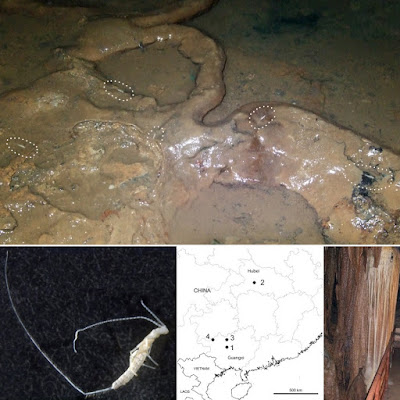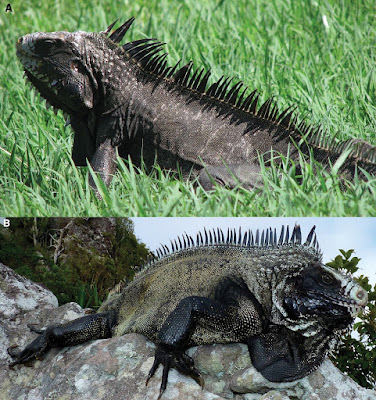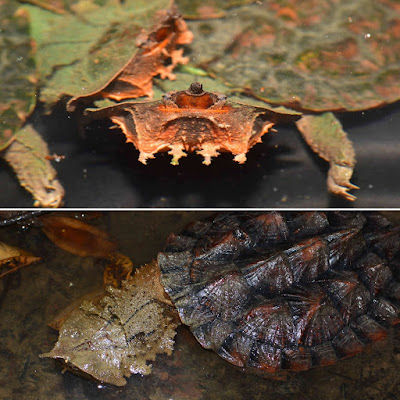[Most Recent Entries] [Calendar View]
Wednesday, April 15th, 2020
| Time | Event | ||||||
| 3:03a | [Invertebrate • 2020] Whittencampa troglobia • A New Genus and Species of Troglomorphic Plusiocampinae (Diplura: Campodeidae) from China
Abstract Whittencampa troglobia, new genus and new species, is a highly troglomorphic Diplura of the Plusiocampinae subfamily described from Lian Hua Dong Cave in southern China. Whittencampa belongs to the Plusiocampinae subfamily, which is widely distributed in the European region, but also has four species in China. Whittencampa is characterised by its thick setiform pretarsal processes completely covered with long barbs with a tiny hooked tip. Whittencampa shares important features with other members of the subfamily, in particular the distribution pattern of notal, femoral and abdominal macrosetae, including the presence of an isolated pair of macrosetae on the eighth urosternite; the last trait characterises the Chinese Plusiocampinae. Scanning electron microscopy reveals new features for this subfamily such as the large subtriangular ending of the neuroglandular setae on the labial palps, the epidermal glands on the labial palps and the bifurcated or double sac ending of the eversible abdominal vesicles. Whittencampa troglobia has remarkable troglomorphic traits: the most elongated antennae, and the largest number of antennomeres (56) among Plusiocampinae, and cerci up to 2.3 times longer than the body. It lives with other highly troglomorphic arthropods at the type locality, Lian Hua Dong, and provides additional evidence that southern China is one of the major biodiversity world hotspots for subterranean fauna. Key words: subterranean fauna, East Asia, Whittencampa troglobia, troglomorphy
SYSTEMATICS Class Hexapoda Blainville, 1816Order Diplura Börner, 1904 Suborder Rhabdura Cook, 1896 Family Campodeidae Lubbock, 1873 Subfamily Plusiocampinae Paclt, 1957 Whittencampa, new genus Type species. Whittencampa troglobia, new species. Etymology. Whittencampa is named in honour of Tony Whitten, who passed away in November 2017. Tony was an enthusiastic initiator and efficient facilitator of biospeological expeditions in China, which allowed the discovery of this new genus, among many other remarkable taxa. Gender: feminine. Diagnosis. On pronotum 1+1 ma, 1+1 la4 and 2+2 lp1,3, on meso- and metanotum 1+1 ma, 1+1 la, and 2+2 lp2,3 (Figs. 1–3); two dorsal femoral macrosetae; without tibial macrosetae; unequal claws with lateral-crests (Figs. 12, 13); two thick setiform pretarsal processes completely covered with long barbs (Figs. 12, 13, 15); male and female without glandular field on the posterior part of the first urosternite; first urosternite of male with large subcylindrical appendages with conical ending and carrying long glandular a1 and a2 setae (Figs. 16, 17); female with small subcylindrical appendages with concal ending on first urosternite, with long glandular a1 setae; sac of eversible vesicles with double ending (Figs. 18, 19); 1+1 post urotergal macrosetae on III– IV, 4+4 post on V–VII, 5+5 post on VIII and 7+7 post on IX; 13+13–10+10 macrosetae on urosternite I, 5+5 on II– VII and 1+1 macrosetae on VIII (Fig. 20); large subtriangular ending of neuroglandular setae and epidermal glands on labial palps (Figs. 5–10, under SEM magnification); dense barbs on macrosetae on abdominal sternites, legs and calcars (Fig. 11); glandular a1 and a2 setae long and slender (Fig. 17). Whittencampa troglobia, new species Etymology. The epithet emphasises the ecology of the new species, strictly linked to subterranean habitats (from the greek trogle (τρωγλη), which means hole.  Alberto Sendra and Louis Deharveng. 2020. Whittencampa troglobia, A New Genus and Species of Troglomorphic Plusiocampinae from China (Diplura: Campodeidae). RAFFLES BULLETIN OF ZOOLOGY. Supplement No. 35; 68-77. | ||||||
| 3:35a | [Herpetology • 2020] Iguana melanoderma • Painted Black: A New Melanistic Endemic Species of Iguana Laurenti, 1768 (Squamata, Iguanidae) from Saba and Montserrat Islands (Lesser Antilles)
Abstract The Lesser Antilles, in the Eastern Caribbean, is inhabited by three Iguana species: the Lesser Antillean iguana Iguana delicatissima, which is endemic to the northernmost islands of the Lesser Antilles, the introduced common iguana from South America, Iguana iguana iguana, represented also by the two newly described endemic subspecies Iguana iguana sanctaluciae from Saint Lucia and Iguana iguana insularis from Saint Vincent and the Grenadines, and Grenada, and the introduced Iguana rhinolopha from Central America. Drawing on both morphological and genetic data, this paper describes the Iguana populations from Saba and Montserrat as a new species, Iguana melanoderma. This species is recognized on the basis of the following combination of characteristics: private microsatellite alleles, unique mitochondrial ND4 haplotypes, a distinctive black spot between the eye and tympanum, a dorsal carpet pattern on juveniles and young adults, a darkening of body coloration with aging (except for the anterior part of the snout), a black dewlap, pink on the jowl, the high number of large tubercular nape scales, fewer than ten medium sized–triangular dewlap spikes, high dorsal spikes, and lack of horns on the snout. This new melanistic taxon is threatened by unsustainable harvesting (including for the pet trade) and both competition and hybridization from escaped or released invasive alien iguanas (I. iguana iguana and I. rhinolopha) from South and Central America, respectively. The authors call for action to conserve Iguana melanoderma in Saba and Montserrat and for further research to investigate its relationship to other melanistic iguanas from the Virgin Islands and coastal islands of Venezuela. Keywords: Conservation Biology, Iguana, Lesser Antilles, microsatellites, mtDNA, new endemic species, phylogeny Iguana melanoderma sp. nov. Diagnosis: A species of Iguana, with a distinctive melanistic phenotype, with a black dewlap, huge tubercular nape scales, the absence of horns on the snout. Etymology: The name was chosen to emphasize the most conspicuous feature of this new taxon, from melano meaning black and derma meaning skin. Common local names are: Melanistic Lesser Antilles iguana, Saban Black iguana
Michel Breuil, David Schikorski, Barbara Vuillaume, Ulrike Krauss, Matthew N. Morton, Elizabeth Corry, Nicolas Bech, Mišel Jelić and Frédéric Grandjean. 2020. Painted Black: Iguana melanoderma (Reptilia, Squamata, Iguanidae) A New Melanistic Endemic Species from Saba and Montserrat Islands (Lesser Antilles). ZooKeys. 926: 95-131. DOI: 10.3897/zookeys.926.48679 | ||||||
| 10:06a | [Herpetology • 2020] Chelus orinocensis & C. fimbriata • Genomic Analyses reveal Two Species of the Matamata (Testudines: Chelidae: Chelus spp.) and Clarify Their Phylogeography
Highlights • Another species of matamata (Chelus orinocensis), one of the most bizarre turtles of the world, is described as new to science. • Chelus orinocensis differs genetically and morphologically significantly from C. fimbriata. • The two species diverged in the late Miocene, approximately 13 million years ago. • Chelus orinocensis occurs in the Orinoco and Río Negro Basins and the Essequibo drainage; C. fimbriata sensu stricto is restricted to the Amazon Basin and the Mahury drainage. • Chelus orinocensis possess in the Essequibo and Branco Rivers introgressed haplotypes from C. fimbriata. Abstract The matamata is one of the most charismatic turtles on earth, widely distributed in northern South America. Debates have occurred over whether or not there should be two subspecies or species recognized due to its geographic variation in morphology. Even though the matamata is universally known, its natural history, conservation status and biogeography are largely unexplored. In this study we examined the phylogeographic differentiation of the matamata based on three mitochondrial DNA fragments (2168 bp of the control region, cytochrome oxidase subunit I, and the cytochrome b gene), one nuclear genomic DNA fragment (1068 bp of the R35 intron) and 1661 Single Nucleotide Polymorphisms (SNPs). Our molecular and morphological analyses revealed the existence of two distinct, genetically deeply divergent evolutionary lineages of matamatas that separated in the late Miocene (approximately 12.7 million years ago), corresponding well to the time when the Orinoco Basin was established. As a result of our analyses, we describe the genetically and morphologically highly distinct matamata from the Orinoco and Río Negro Basins and the Essequibo drainage as a species new to science (Chelus orinocensis sp. nov.). Chelus fimbriata sensu stricto is distributed in the Amazon Basin and the Mahury drainage. Additionally, the analyses revealed that each species displays phylogeographic differentiation. For C. orinocensis, there is moderate mitochondrial differentiation between the Orinoco and the Río Negro. For C. fimbriata, there is more pronounced differentiation matching different river systems. One mitochondrial clade was identified from the Amazon, Ucayali, and Mahury Rivers, and another one from the Madeira and Jaci Paraná Rivers. The C. orinocensis in the Essequibo and Branco Rivers have haplotypes that constitute a third clade clustering with C. fimbriata. Phylogenetic analyses of the R35 intron and SNP data link the matamatas from the Essequibo and Branco with the new species, suggesting past gene flow and old mitochondrial introgression. Chelus orinocensis is collected for the pet trade in Colombia and Venezuela. However, neither the extent of the harvest nor its impact are known. Hence, it is crucial to gather more information and to assess its exploitation throughout its distribution range to obtain a better understanding of its conservation status and to design appropriate conservation and management procedures. Keywords: Amazonas, Chelus orinocensis sp. nov., mtDNA, nDNA, Orinoco, South America, Taxonomy photos: Fernando Trujillo. Chelus orinocensis sp. nov. Etymology: The species name orinocensis is a Latinized adjective and refers to the Orinoco drainage as core distribution of the new species. Proposed vernacular names: Orinoco matamata (English), mata-mata do Orinoco (Portuguese), matamata orinocence, matamata del Orinoco, caripatúa (Spanish). The Sikuani indigenous group, native people in the Orinoco region, name this turtle “Atzapani”. For Chelus fimbriata the following vernacular names are proposed: Amazon matamata (English), mata-mata amazônica (Portuguese), matamata amazonica, matamata del Amazonas (Spanish). Distribution: Chelus orinocensis occurs in the Orinoco Basin and the upper Río Negro (Amazon Basin) in north-western South America, .... Lasso, et al, 2018. DOI: 10.21068/c2018.v19n01a10 photos: Fernando Trujillo. Mario Vargas-Ramírez, Susana Caballero, Mónica A. Morales-Betancourt, Carlos A. Lasso, Laura Amaya, José Gregorio Martínez, Mariadas Neves Silva Viana, Richard C. Vogt, Izeni Pires Farias, Tomas Hrbek, Patrick D. Campbell and Uwe Fritz. 2020. Genomic Analyses reveal Two Species of the Matamata (Testudines: Chelidae: Chelus spp.) and Clarify Their Phylogeography. Molecular Phylogenetics and Evolution. In Press, 106823. DOI: 10.1016/j.ympev.2020.106823 C.A. Lasso, F. Trujillo, M.A. Morales-Betancourt, L. Amaya, S. Caballero, B. Castañeda Carlos A. Lasso, Fernando Trujillo, Monica A. Morales-Betancourt, Laura Amaya, Susana Caballero and Beiker Castañeda. 2018. Conservación y tráfico de la tortuga matamata, Chelus fimbriata (Schneider, 1783) en Colombia: un ejemplo del trabajo conjunto entre el Sistema Nacional Ambiental ONG y academia [Conservation and trafficking of the Matamata Turtle, Chelus fimbriata (Schneider, 1783) in Colombia: an example of joint efforts of the National Environmental System, one NGO, and academia]. Biota Colomb. 19(1); 147-159. DOI: 10.21068/c2018.v19n01a10 Red de tráfico internacional pone en riesgo a extraña especie de tortuga de la Orinoquia RESUMEN: La matamata es una de las tortugas más carismáticas del mundo, ampliamente distribuida en el norte de Sudamérica. Debido a su variación morfológica geográfica, se debate sobre el reconocimiento de dos subespecies o especies. A pesar de que la matamata es universalmente conocida, su historia natural, estado de conservación y biogeografía han sido muy poco estudiados. En este estudio examinamos la diferenciación filogeográfica de las matamatas en base a tres fragmentos de ADN mitocondrial (2168 pb de la región de control, la subunidad I del citocromo oxidasa y el gen del citocromo b), un fragmento de ADN genómico nuclear (1068 pb del intrón R35) y 1661 polimorfismos de nucleótido único (SNP). Nuestros análisis moleculares y morfológicos revelaron la existencia de dos linajes evolutivos distintos de matamatas, genéticamente divergentes que se separaron en el Mioceno tardio (hace aproximadamente 12.7 millones de años), correspondiendo al tiempo en que se estableció la cuenca del Orinoco. Como resultado de nuestros análisis, describimos las genéticamente y morfológicamente distintas matamatas de las cuencas del Orinoco, Río Negro y Essequibo como una especie nueva para la ciencia (Chelus orinocensis sp. nov.). Chelus fimbriata sensu stricto se distribuye en la cuenca del Amazonas y en el drenaje del Mahury. Adicionalmente, los análisis revelaron que cada especie muestra diferenciación filogeográfica. Para C. orinocensis, hay una moderada diferenciación mitocondrial entre el Orinoco y el Río Negro. Para C. fimbriata, hay una diferenciación más pronunciada, concordando con los diferentes sistemas fluviales. Se identificó un clado de los ríos Amazonas, Ucayali y Mahury y otro de los ríos Madeira y Jaci Paraná. Las C. orinocensis de los ríos Essequibo y Branco tienen haplotipos que constituyen un tercer clado que se agrupa con C. fimbriata. Los análisis filogenéticos del intrón R35 y los datos de SNP asocian las matamatas de Essequibo y Branco con la nueva especie, sugiriendo flujo de genes pasado e introgresión mitocondrial antigua. Chelus orinocensis se colecta para el comercio de mascotas en Colombia y Venezuela. Sin embargo, ni se conoce el alcance de las colectas ni su impacto. Por lo tanto, es crucial recopilar más información y evaluar su explotación en todo su rango de distribución, comprender mejor su estado de conservación y para diseñar acciones apropiadas de conservación y manejo. |
| << Previous Day |
2020/04/15 [Calendar] |
Next Day >> |






























